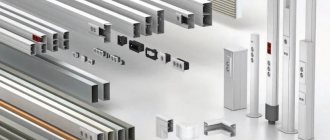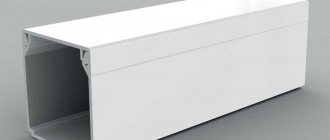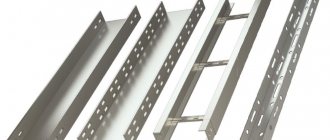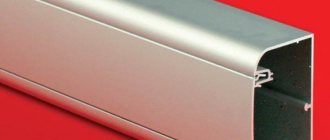Review of models on the market
Junction box Tuso
Characteristics:
- diameter 60 mm, depth 40 mm;
- installation, or branching;
- round in shape, consisting of a body and a lid;
- body and cover material – non-flammable plastic;
- fixing the cover with latches in the cover and body;
- used for installation in concrete and brick walls;
- it is possible to mount it openly with screws or self-tapping screws;
- number of inputs – 4 with rubber seals;
- moisture protection class -;
Price – from 20.00 to 35.00 rubles per piece.
Distribution box Legrand Atlantic IK10
Characteristics:
- dimensions 150*150*80 mm;
- rectangular shape for indoor installation,
- metal;
- fixing the cover with screws into the body;
- used for installation in concrete and brick walls;
- Possible mounting through the body or on brackets;
- supplied with perforated mounting rails;
- moisture protection class – IP66;
- internal and external paintwork – textured coating in RAL 7035 color;
Price – from 3173.00 to 3300.00 rubles per piece.
Cross section in electrical box
The size range of sections in mini channels is varied.
The following sizes of such sections are produced in boxes: from 10*10 to 60*80 mm.
The peculiarity is that the device can accommodate up to two wires.
- Floor profiles also differ in cross-sectional sizes. They are produced in sizes ranging from 160*65 to 75*17 mm.
- Plastic profiles for main use are produced in the following cross-sectional sizes - from 20*10 to 100*60 mm.
Dimensions of plastic wiring box
Wires for electrical wiring
Plastic boxes for electrical wiring vary in length, width and thickness.
According to section 8 “Dimensions” of GOST R IEC 61084-1-2007 “Cable and special cable duct systems for electrical installations”, it is recommended to produce straight sections of cable channels with a length that is selected from the size range in increments of 0.5 m. Minimum section length should be 2 m.
This section also indicates that the manufacturer must indicate the value of the cross-sectional area (in mm2) inside the box, that is, the usable area that can be used when installing the cable.
The width of the box depends on the number of wires that can be placed inside, as well as on the purpose of the product itself.
Dimensions of electrical installation cable channels in cross section
Mini-channels are produced by industry with the following typical cross-sectional dimensions:
- 10x10mm;
- 10x12mm;
- 12x12mm;
- 12x16mm;
- 16x16mm;
- 16x20mm;
- 20x20mm;
- 20x25mm;
- 25x25mm;
- 25x40mm;
- 40x40mm;
- 40x60mm;
- 60x80mm.
Trays of this type are designed to accommodate one or two wires.
Floor boxes are produced with the following cross-section:
- 160x65mm;
- 50x12mm;
- 92x20mm;
- 75x17mm.
Trunk plastic boxes for electrical wiring have the following typical cross-sectional dimensions:
- 20x10mm;
- 30x10mm;
- 40x25mm;
- 25x25mm;
- 40x40mm;
- 40x16mm;
- 80x60mm;
- 100x60mm.
For the plinth type, the size is determined by the width of the cover (diagonal wall) and is usually made 50 or 70 mm. You can also find the sizes of skirting boards with cable channels, which are given according to the height and width of the base. In this case, the most popular are 50x50 mm skirting boards. They allow you to place several wires in one product. Trays measuring 100x100 are designed to accommodate three-wire wires.
Dimensions for corner structures depend on the dimensions of the internal part of the product. The most popular size is 40x40 mm.
Depending on the purpose, flexible corrugated models are available in the following diameters: 16mm; 20mm; 25mm and 50mm.
- 16mm pipes are used for laying lighting and telephone cables;
- to create outlets for sockets or switches, use 20mm corrugated channels;
- Corrugated cable ducts with a pipe diameter of 25 mm are used between electrical panels or distribution boxes.
The industry also produces cable channels designed to accommodate LED strips; they are produced in widths from 5 to 20 mm. In addition, LED channels can be located in plinth boxes.
Skirting electrical installation tray with LED channel
Wall thickness of plastic cable channels
Depending on the size of the trays, products with different wall thicknesses are produced. The strength and flexibility of the box depends on its value.
Small mini-channels are made with a wall thickness of 0.7 mm. Medium-sized boxes (from 20 to 40 mm wide) have a thickness of about 1.3 mm. Wide main profiles (from 60 to 100mm) are manufactured with a thickness of 2.4mm.
In addition to boxes of standard sizes, many companies produce custom-made products made to customer sizes.
Basic Concepts
Cable channels are specialized boxes designed for laying wires for various purposes and protecting them from mechanical damage and other environmental influences.
On a note. If you hear somewhere the terms “electrical boxes”, “cable ducts”, “cable trays”, “electrical cable trays”, etc., know that we are talking about the same cable channels.
Cable boxes for electrical wiring are usually rectangular or square in shape and consist of a body and a cover, which are connected to each other with locks. The most popular is the double lock, the grooves of which are flexible, and the design eliminates the possibility of spontaneous separation of the housing and the cover of the cable channel.
Inside the box there may be partitions that divide it into several gutters. This design allows cables to be separated when laid in a cable channel. This helps avoid wire tangling and makes further maintenance of the entire system easier.
The most popular materials for making cable ducts are metals and various types of plastic. Metal boxes for electrical wiring are usually made of aluminum or its alloys. It is highly desirable for the plastic from which the cable duct for electrical wiring is made to have the properties of resistance to high temperatures and fire resistance.
Plastic cable channel
In everyday life, plastic boxes for wires are most popular, since their materials allow you to create products of various colors and shapes. This, in turn, can be used so advantageously in the interior that the cable channel will not only not be an eyesore, but will also become, to some extent, a decorative element.
Select cable channel
The main parameter for choosing a mounting box is the size of its internal section. When buying a cable channel, the dimensions are selected depending on the number and sum of the diameters of all wires and cables placed inside its cavity. The wires should lie freely, not tightly, so that there is always free access to any of them.
In most cases, simple rectangular boxes are used. But in complex wiring systems or for laying heterogeneous networks, products with separated channels are chosen.
The standard cable duct is 2 m long. The rods are easily joined with a top cover or special plastic joints.
In addition to rectangular ones designed for installation on walls and ceilings, there are special boxes for the floor. The floor cable channel has a streamlined cover to prevent your foot from getting caught in it.
The strength of such a box is sufficient to support the weight of an adult. When choosing for a private house, it is enough to take into account both the load - the weight of the residents plus 20-30 kg, and for utility rooms - the possibility of transporting or carrying loads - plus 50-80 kg.
To pass the external and internal corners of the room, external and internal corners are used. Plugs are installed at the ends of the rods. Cable channel systems can also include surface-mounted sockets, splitters, junction boxes and other elements that are embedded into the wall during the usual installation method.
Selecting an electrical box
Plastic trays with a lid are ideal for installing power supply networks indoors. The sale is dominated by various shades of white, which look harmonious against the background of the many colors in which the walls and ceilings of houses are decorated. The main selection criterion will be the width of the box, which should accommodate all the cables being mounted. It is calculated with a reserve for future needs.
Reserves are also required for the length of the route. Usually it is ten to fifteen percent of the total length of the line. The width of the main line box is, as a rule, larger than the branches to other consumers.
When purchasing the main wiring part, you must not forget about the fittings: transitions, plugs, joints. These elements will simplify the installation process and make the appearance of the route much more aesthetically pleasing.
And, of course, all parts of the structure should not have cracks, chips, or other defects. This is especially true for the ends, which are difficult to fit perfectly if cut unevenly. Some buying tips:
- Cable ducts in the form of corrugated pipes are intended exclusively for flexible wire.
- Small profile boxes are cut with a sharp knife, wide ones - with a saw with a fine tooth. When using an angle grinder, the profile may melt.
- Installation of cable channels begins with electrical fittings (lights, sockets, switches, junction boxes).
- The quantity of fasteners is purchased at the rate of one piece for every half meter of tray.
- Rigid profile boxes are installed on flat surfaces.
Tips for installing cable ducts
hide wiring
Before attaching the box to the surface, you should check its evenness
It is important that there are no bumps or bends, but the owner must take care of this even before the installation of open electrical wiring begins. The cable duct should be cut using a grinder, as jigsaws and knives leave burrs and damage the integrity of the structure. Try to secure cable ducts with liquid nails or special glue. In these cases, it is better not to use self-tapping screws. It is advisable to buy boxes that have an internal partition - this property is very convenient during installation.
Important! By following our advice and selection rules, you will get the ideal aesthetic solution for your home
Selecting cable channels for electrical wiring
The choice of boxes intended for electrical installations is based not only on the types of design, but also on some other factors. Of course, before purchasing, the owner must know exactly what size protective device he needs. Retail outlets usually do not cut channels into the dimensions you need, so it is better to take a device with a small margin.
To plan the distribution of cables at home, it is better to use plastic or lightweight metal boxes. When choosing them to match the main color of your interior, you will have to order designs in advance, since in addition to white cable ducts, you are unlikely to find a shade that suits you.
What can I say about the dimensions of the structure? It is important that there is enough space inside the box to accommodate a certain number of cables, and it is better if there is some reserve left
The presence of accessories for the cable channel is a prerequisite
At the point of purchase, immediately make sure that all plugs, mounting fasteners and locks are in place. Test the box lock for efficiency: it should open easily without any tools
The difference between cables and wires depending on the core material
Cores of wires and cables for specialized purposes can be made of various metals, but aluminum and copper are mainly used in electrical engineering. Each of them has its own specific properties, advantages and disadvantages, which must be taken into account when selecting a core material for a specific purpose.
Aluminum conductors
The invention of a relatively inexpensive method for extracting aluminum made a revolution in the global development of electrification, because in terms of electrical conductivity this metal ranks fourth, behind only silver, copper and gold. This made it possible to reduce the cost of production of wires and cables as much as possible and make universal electrification a reality.
Such electrical wires and their types are distinguished by their low cost, chemical resistance, high level of heat transfer and low weight - they have determined the mass of electrification in industrial and domestic conditions for more than half a century.
In light of the relatively recent dominance of aluminum in the wire market, it may seem strange to the uninitiated that the provisions of the PUE prohibit the use of this material in everyday life. More precisely, you cannot use aluminum wires with a cross-section of less than 16 mm², and these are the most common of them for installing home electrical wiring. To understand why there is a ban on the use of these wires, you can familiarize yourself with their advantages and disadvantages.
+ Advantages of aluminum wires
- Lighter than copper.
- Significantly cheaper.
— Disadvantages of aluminum wires
- Aluminum conductors with a cross-section of up to 16 mm² can only be single-wire, which means they can only be used for laying stationary wiring and without bending at an acute angle. All flexible wires and cables have always been made of copper.
- The chemical resistance of aluminum is determined by the oxide film that forms when it comes into contact with air. Over time, with constant heating of the contact due to the flow of electric current through it, this film deteriorates electrical conductivity, the contact overheats and fails. That is, aluminum wires require additional maintenance, and the contacts through which powerful currents pass are coated with a special lubricant.
- Amorphous material - if you clamp two aluminum wires together, the contact will weaken over time, as the aluminum will partially “leak out” from under pressure.
- Soldering can only be carried out using special tools, and welding can be performed in a chamber with an inert gas.
- Good electrical conductivity is observed only in pure aluminum, and impurities inevitably remaining during production worsen this indicator.
As a result, aluminum is a good choice if you need to save money here and now, but in the long run its use will be more expensive due to its relatively short service life and the need for regular maintenance. For this reason and additional safety reasons, the PUE strictly prohibits using it for laying new power lines.
Copper conductors
In terms of electrical conductivity, copper is in second place, only 5% inferior to silver in this indicator.
Compared to aluminum, copper has only 2 significant disadvantages, due to which for a long time it was used much less frequently. Otherwise, copper wins in all respects.
+ Pros of copper wires
- Electrical conductivity is 1.7 times higher than aluminum - a smaller cross-section of wire will pass the same amount of current.
- High flexibility and elasticity - even single-core wires can withstand a large number of deformations, and multi-core wires make cords for electrical appliances with increased flexibility.
- Soldering, tinning and welding are carried out without the use of additional materials.
— Disadvantages of copper wires
- The cost is several times more expensive than aluminum.
- High density - a coil of copper wire, the same length and cross-section as aluminum, will weigh 3 times more.
- Copper wires and contacts oxidize in open air. However, this practically does not affect the contact resistance and, if necessary, is “treated” by lubricating the surface of the already tightened contact.
As a result, although copper is a more expensive material, in general its use is more economical, since it is more durable, requires less effort during installation and attention during maintenance.
Flexible cable channels
The need for flexible protection of electrical wiring is dictated by the peculiarities of the “relief” of the walls of the house and outbuildings. If there is an unevenness on the wall (a seam, a plate joint, a difference) whose height exceeds 2 mm, consider that the cable channel will show it “in all its glory.”
In residential premises it is possible and even necessary to level the walls, but in wooden outbuildings such a “luxury” may be too expensive. It is for such cases that flexible cable channels for wires are created.
Types of flexible cable channels:
- “flexible chains” (or “tracks”) are multi-sectional structures that can bend along their entire length in one plane (up and down). Each element of the “chain” is connected to adjacent links by a hinged linkage and has a snap-on lid. There are small gaps between the links, which is why the cable channels are called “semi-closed”.
- tubular: flexible cable channel for transition to the door;
- molded from soft plastic or artificial rubber.
“Flexible chains” are difficult to manufacture, so their cost is quite high. Used in production to connect machines. The owner of a private household can use such a cable duct to protect the cable to a drilling or grinding machine (“emery machine”). Or in the garage. The width of the “flexible chains” is from 2 to 23.4 cm.
The flexible cable channel for connecting to the door consists of a flexible metal hose and two fasteners (attached to the wall and door). “Flexible armor” can be bent countless times, but only if there are flexible wires inside (twisted from thin wire).
Typically, such transitions are used to power electrical locks and sensors.
Cable channels molded from rubber or soft plastic can be called “protection from all types of damage.” Sufficiently thick walls can prevent moisture from entering. In a private house, a cast cable channel can protect the electrical wiring of a bathhouse (except for a steam room).
What does the box consist of?
The plastic alloy profile consists of two elements: the base and the cover. The main part is represented by the letter <<П>> and is intended for attaching the box to the required surface. The cable or wires are located in this base.
It should contain fastening recesses, but it happens that they are not enough. There is no problem here, because the holes are easy to make yourself using a drill.
The distance between the recesses should be 30-50 cm. And the holes are located along the entire length of the device.
The main part of the profile is equipped with a partition.
- Its role is to separate the cable and box latches from each other.
- The devices are connected to each other using couplings or a partition part.
- It is also worth noting that PVC profiles are available for sale in two types - a flexible and a rigid device.
- Regardless of the species, they contain minerals.
The boxes are divided into multi-sectional and single-sectional devices. The first option is designed to place wires in two levels. The second type is necessary to protect one electrical equipment from damage.
Rigid case
The housing cable channel is a straight box made of metal or plastic.
The following types of rigid cable channels for electrical wiring are produced:
- a box with holes in the walls and bottom, without a top cover;
- a box with blank walls and a bottom, without a top cover;
- box with a removable snap-on lid and blank walls.
Metal cable channels (without covers) are used in the installation of electrical wiring hidden inside frame structures: in suspended ceilings, internal partitions, raised floors.
The convenience of such boxes is that they are easy to fasten: the cable channel is screwed to the supporting structures with self-tapping screws, the wires are laid inside the box and secured with plastic clamps.
In boxes with profiled slots, the cooling of the wires is more uniform, which has a positive effect on electrical conductivity.
Closable boxes are designed for installation on the surface of walls and ceilings. Manufacturers of electrical fittings use self-extinguishing plastic PVC (polyvinyl chloride) in the production of cable channels for electrical wiring.
Pure PVC is very flexible, but various mineral additives (gypsum, marble) make it hard. Plastic holds paint well and does not fade for years.
Colored cable channels for electrical wiring cost almost the same as white ones. But technologies have emerged for applying designs to plastic using the “photoprint” method. Abstract drawings are more expensive because they are “designer novelties.”
Wide cable channels can have several internal walls for individual lines.
Aluminum cable channels look elegant and expensive on the walls. Such Italian and German delights are no cheaper than the most exclusive “photo prints”. Metal boxes have one advantage that plastic boxes lack - insulation from electromagnetic interference and interference.
A separate type of box-shaped cable channels is a hollow plastic plinth. The box for the wires is attached to the wall, and the cover (which is also a decorative “plinth”) is fixed and covers the junction of the floor and the wall. The design of the baseboards is very diverse, including “wood-like” (the casting imitates the grain of wood).
The boxes are equipped with connection elements: transitions from wide to narrow cable channels, 90° turns, tees, crosses, corners (internal and external), boxes.
The elements are equipped with covers and are connected to “lengths” so that they appear to be a single whole.
Classification
The classification of such product names as distribution boxes is most often carried out according to the type of installation:
For hidden wiring
It is intended for installation at the junction of wires in a special wall opening or partition voids, so that wiring laid in special channels or simply hidden by plaster does not come out. The cover of such a product, after installation and connection of the bends, is also hidden under plaster or putty.
For open wiring
The open arrangement of the distribution unit provides for fixing both the box itself and the boxes for laying electrical wires on top of the wall surface. This option is mainly present in electrical wiring equipment for office, industrial and commercial premises.
In private housing construction, external wiring is mainly for utility and technical rooms. The convenience of the outdoor option is quick access to the connection point of the wires, which makes them indispensable for rooms with a large number of consumers.
This division largely reflects the basic, but not the most complete classification of the characteristics of a given product. At the same time, this classification is the main one today for most sellers and consumers.
In addition to classification by type of installation, there is a classification by purpose and degree of safety of this equipment. This type of separation exists for special rooms and provides the greatest degree of safety for this type of room - protecting electrical equipment from the influence of the indoor environment.
This classification reveals more deeply the purpose of electrical distribution boxes, while each class has its own characteristics:
- Conventional protected distribution boxes - can be used both in ordinary premises and industrial premises, they are designed for a standard voltage of 220 V, most often have a lid without a rubber gasket, and the input points have standard rubber seals.
- Dust-proof boxes are designed for installation in rooms with a high content of dust or other dusty particles, the penetration of which into the housing can negatively affect the operation of the entire power supply system.
- Splash-proof options are designed for rooms with high air humidity; they have a special rubber gasket and rubber seals that provide reliable protection of the wire connection from moisture penetration inside.
- Fire resistant, increased strength. In rooms where explosive work is carried out, highly flammable liquids and materials are used, safety requirements must be ensured at the highest level; it is for such rooms that boxes are installed that ensure reliable fastening of both the wires themselves and their retention in special clamps inside the installation compartment.
Scope of application
The profile is used to terminate the following wires:
- television;
- computer;
- telephone;
- power electrical;
- low-current (fire and video surveillance).
The mounting box (most often plastic) is installed:
- in private homes;
- in apartments;
- in the baths;
- in offices;
- at production facilities;
- in administrative complexes;
- in medical institutions;
- in educational facilities;
- in entertainment centers.
In general, a box is an electrical device that is suitable anywhere and everywhere.
Types of electrical installation channels
Types and types of electrical wiring
Cable channels are classified according to purpose, material of manufacture, number of locks, shape, etc.
Depending on the material, the cable channel is:
- metal;
- plastic;
- wood.
Based on location and purpose, the following types are distinguished:
- floor;
- corner;
- baseboards;
- wall;
- ceiling;
- flexible;
- LED
Types of cable channels
Floor-standing models are used when installing electrical wiring directly on the floor surface.
Skirting - used when laying electrical wiring along the corner formed between the floor and the wall. Such products are hollow plinths, in which there are special niches or channels for placing electrical cables. Some types have separate channels, which allows you to separate wires for different purposes.
Placing wires in the plinth cable channel
If the wiring runs along a corner formed by two walls or a wall and a ceiling, then corner models are used, which in cross-section represent a triangle.
When placing electrical cables along walls or ceilings, wall or ceiling profiles are used, respectively.
Flexible types are used for laying electrical networks to industrial equipment that is not permanently fixed. They are chain and corrugated. Chain - consist of PVC links connected to each other. Corrugated - they are a corrugated pipe, inside of which wires are laid.
LED trays have a special strip inside on which the LED strip is fixed. Installed in those places where lighting of this type is organized. Such designs have a transparent lid.
Flexible plastic cable channel
Based on the type of wires that can be placed inside the product, there are:
- cable channels designed for laying telephone cables, as well as Internet, signal and television wires (mini cable channels);
- electrical installation boxes for regular and thick cables.
Advantages and disadvantages of electrical channels
Having settled on the option of open installation of cable routing, it is necessary to analyze the pros and cons of this method and try to maintain the advantages during the work, and reduce the negative phenomena or avoid them altogether.
Pros of using trays:
- Low labor intensity compared to wall gating.
- They can be installed anywhere.
- Constant free access in case of a malfunction or the need to lay an additional power line.
- Quite a high degree of protection of wires from mechanical damage.
- High speed of route installation.
- A large number of cable channel options allows you to combine the power supply line with the interior of the premises.
Minuses:
- The need for additional space, albeit minor.
- Need for additional fittings.
- Possibility of accidental damage (especially in the floor version).
- Sometimes it is not possible to choose a tray exactly to match the main interior background.
Having dealt with all the subtleties in installing cable channels when installing electrical wiring, you can always find a suitable solution that suits you in terms of reliability, ease of use, and design. Moreover, new engineering solutions for laying wires without major interventions in the design of buildings and structures are appearing on the market.
Advantages of using cable channels
The use of plastic electrical trays has its advantages and disadvantages.
Advantages:
- minimum weight;
- the lowest price compared to metal or wooden products;
- do not corrode and are resistant to fungi, bacteria and rodents;
- can be used in rooms with high humidity and sudden temperature changes;
- easy installation and dismantling;
- ease of care;
- fireproof;
- are an additional electrical insulator for wiring;
- are available in various colors.
Flaws:
- more fragile compared to metal or wooden products;
- have a less presentable appearance;
- have a shorter service life.
Calculation of the size of a plastic box for electrical wiring
Before you purchase cable channels for installing electrical wiring, you must first draw a layout diagram of the structure in the room, indicating the type of cable channels and the length of each section. After this, determine the required size of each type of tray. To calculate the size of the box, you need to know the cross-section of the wires and their number.
The length reserve takes into account the additional costs that arise during installation in places with corners, as well as in the event of material damage.
It is also advisable to have free space inside the box, which may be needed when laying additional electrical cables.
There is no need to purchase a wide tray if you initially plan to lay only one cable, since its price also depends on the width of the product. Usually the calculation is carried out taking into account an increase in the number of wires by 2-3 pieces.
Also, taking into account the “Rules for Electrical Installations”, in the case of multi-layer filling of plastic cable channels, the sum of the cross-sections of all conductors located in them should not exceed 40% of the cross-section of the product itself in the case of using a box with a lid or 30% in the case of a blind box.
Table for calculating the minimum dimensions of cable channels
| Wire cross-section, mm2 | Design and dimensions (height and width, mm) of the box | ||||||||||
| single-section | two-section | three-section | |||||||||
| 10x22 | 10x30 | 10x22 | 10x30 | 15x54 | 10x40 | ||||||
| number of wires in one section | |||||||||||
| 1,5 | 10 | 12 | 3 | 3 | 5 | 5 | 19 | 13 | 5 | 4 | 5 |
| 2,5 | 7 | 10 | 2 | 2 | 3 | 3 | 13 | 13 | 3 | 3 | 3 |
| 4 | 4 | 8 | 1 | 1 | 2 | 2 | 10 | 13 | 2 | 2 | 2 |
| 6 | 2 | 3 | 1 | 1 | 1 | 1 | 5 | 5 | 1 | 1 | 1 |
Cable channels are delivered to hardware stores in packages. Depending on the size of the trays, the packaging differs in the number of products and, accordingly, in the total footage. To calculate the total length of cable channels in a package, the number of products is multiplied by the standard length of one tray (2 m).
A table of parameters for one package, depending on the size of one box, is shown in the figure.
Parameters of one package of electrical boxes, depending on their size
On a note. When purchasing boxes, it is advisable to purchase fittings for them (plugs, corners, branches, etc.).
Also, for household purposes, it is better to purchase single-lock products, as they will last longer than double-lock ones. This is due to the fact that the wall thickness of single-lock structures is greater, and, consequently, the products themselves are more durable.
Correctly sized cable channels will allow you to quickly install the system, and the additional space inside the box will make it possible to easily add wires to the system without the use of additional trays.
Small professional BOSCH GSB 13 RE (ZVP) 600 W
The smallest professional model in the top 10. Despite its small size, it weighs 1.8 kg due to the metal gearbox. It is inexpensive - 3500–4100 rubles. Compact, grippy, suitable for long-term work. Speed is adjustable from 0–2800 rpm.
The diameter of holes in metal and wood is up to 10 and 25 mm, respectively. It can work with impact, the quantity is 44800 per minute, which allows you to drill holes in concrete with a cross-section of up to 15 mm. The brand is German, but the assembly of the products is Russian.
Reverse allows you to use the tool as a screwdriver and prevents the drill from getting stuck. An additional handle is included. Key chuck, cam type for a shank with a cross section of 1.5–13 mm. The dimensions allow you to work for a long time without hand fatigue.
Power tools for intensive work. Can be used at home or used by craftsmen.
Owners praise it for its grip, light weight, build quality, and ability to use it as a screwdriver. Many people complain that the kit does not come with a storage case.
Tags: anode, sconce, view, internal, harm, house, , cable, how, design, , tray, , magnet, magnetic, installation, external, rule, wire, start, , work, size, edge, revise, row, garden, light, system, ten, type, current, triangle, , shield, electrical panel











